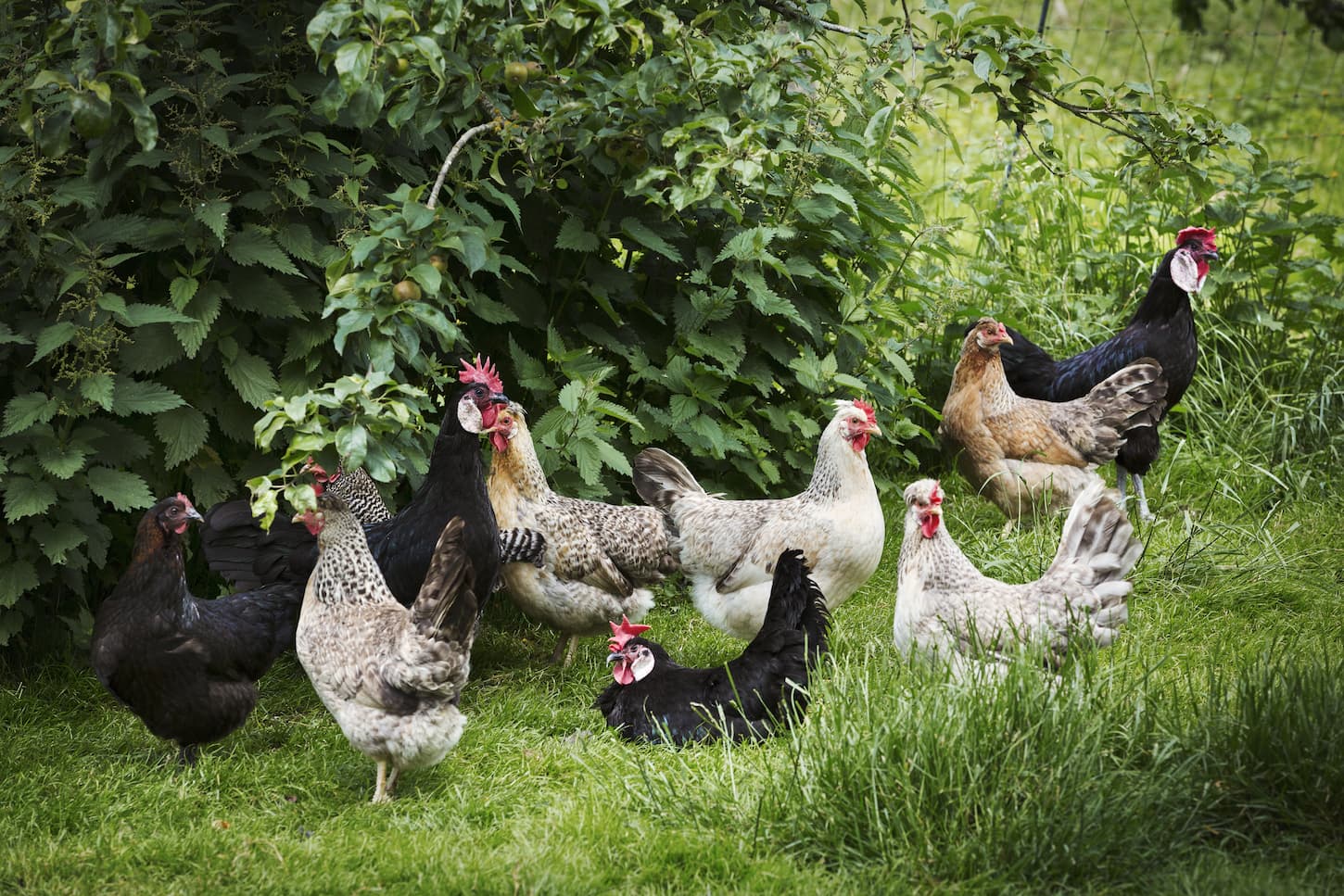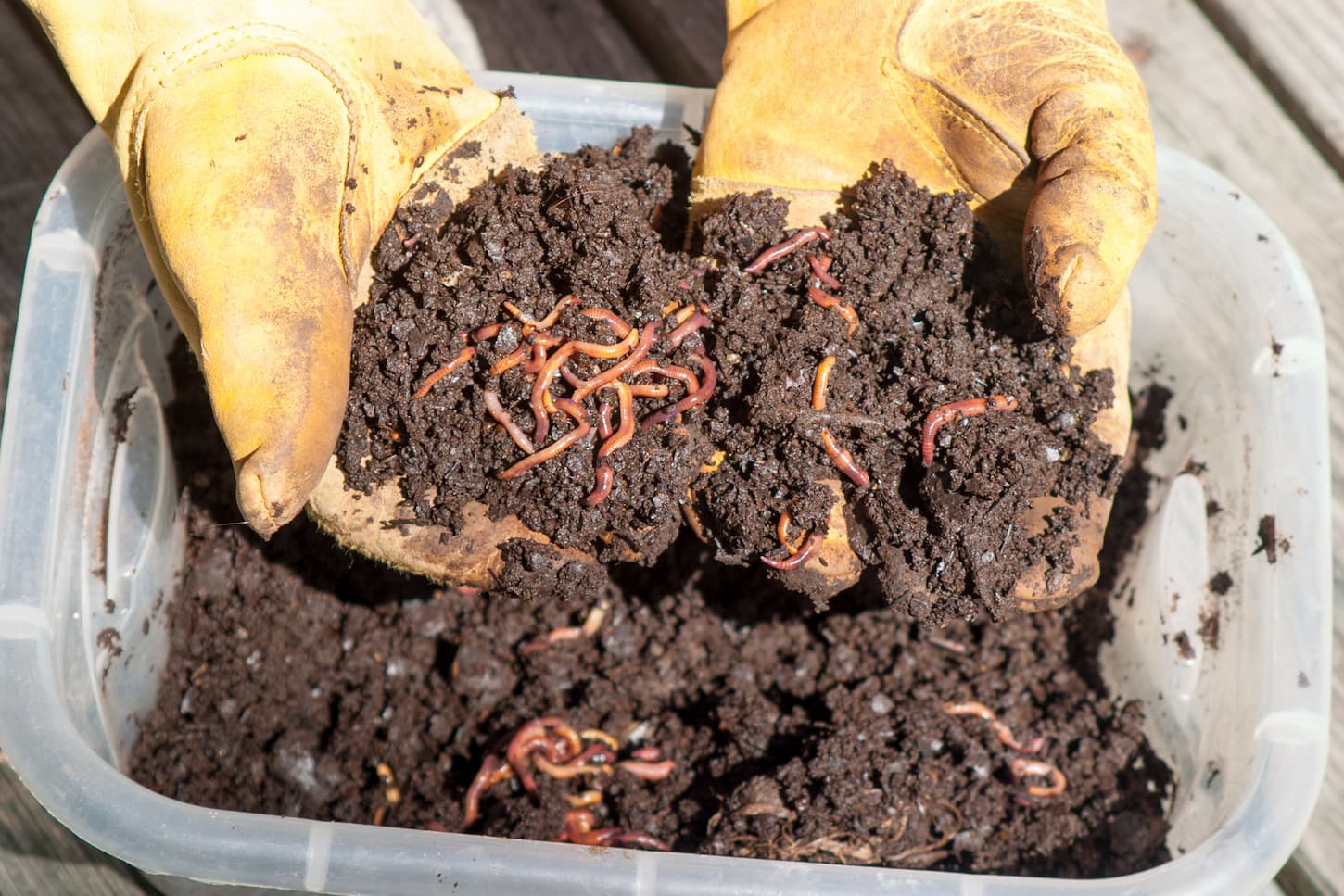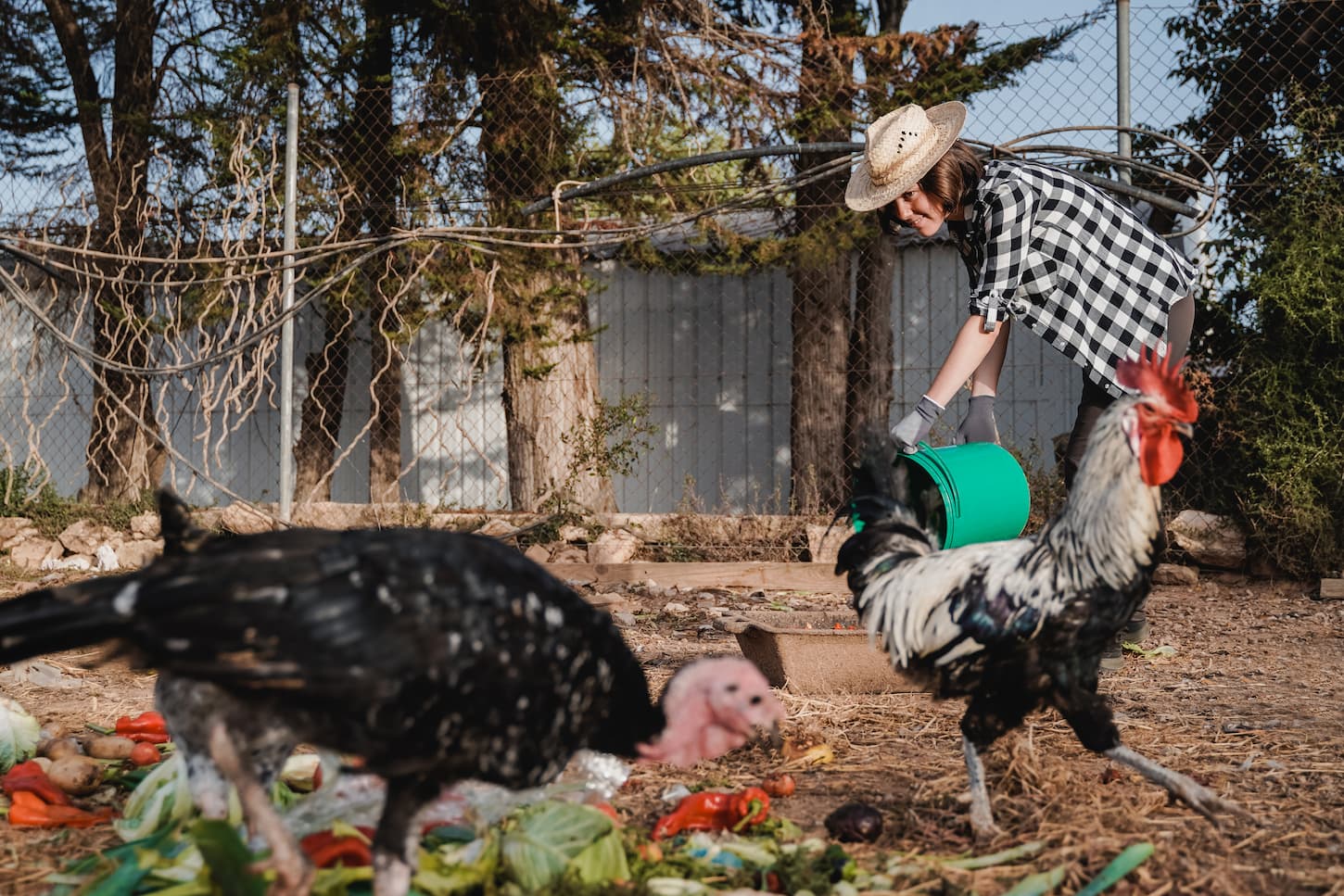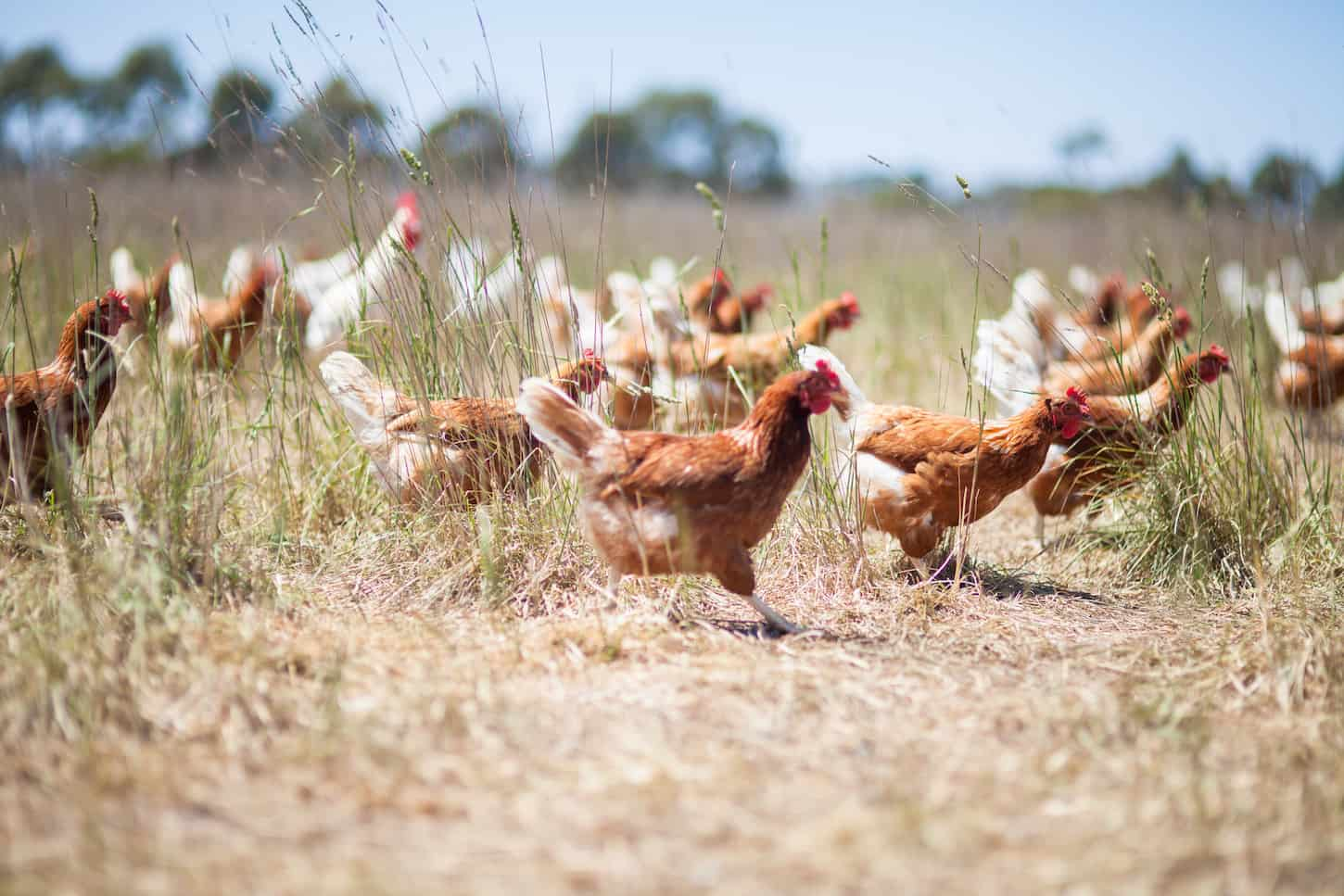Chickens are omnivores, and they like to eat a wide range of foods. They’ll get excited if they find a pile of worms to eat and will spend all day trying to find them. It might be alarming to see chickens gobbling down a pile of earthworms, but worms are safe and healthy for chickens to eat.
Worms are high in protein and rich in amino acids and make a healthy addition to a chicken’s diet. Chickens can get lots of their daily nutritional requirements from worms, but they shouldn’t live on a worm-only diet.
Their diet must be right for a healthy, happy flock of chickens. One way to boost their nutrition is by feeding them worms. Look at our complete guide below to find out everything you need to know about feeding worms to chickens.

Are Worms Good for Chickens?
Worms are excellent for a chicken’s diet – they help them digest food and can increase their immunity. These days, worm meal is often used in poultry feed, and many more farmers are turning to worms for their chickens’ nutrition. Feeding worms to chickens is good for the environment too.
This study showed that broiler chickens supplemented with earthworms and vermi-humus had increased calcium and phosphorus in their blood and less cholesterol.
The chickens also had more antibodies against avian influenza, less intestinal e. coli, and more healthy gut bacteria. The study concluded that eating worms helped chickens absorb and utilize their food better.
Intensively growing food such as grains for animal feed is bad for the environment, so scientists have found more sustainable ways to produce animal food.
It turns out that invertebrates such as worms and algae are a super nutritious food source for some farm animals such as chickens. Furthermore, worms thrive on animal waste, so producing large amounts of worms helps recycle animal waste.
What Are the Best Kinds of Worms for Chickens to Eat?
The best worms for chickens to eat are earthworms and red wigglers. Many people feed mealworms to their chickens, but mealworms aren’t worms – they’re a type of beetle.
Below, we’ll take a closer look at earthworms and red wigglers so you can tell the difference between the two.
Earthworms
Earthworms are also known as nightcrawlers because they like to surface at night. They have a segmented body, and they’re a reddish-brown color.
Earthworms are usually between a quarter of an inch to six inches long, though they can be much longer. Earthworms like to live deep in the earth, so they’re not good for compost bins.
Red Wigglers
Red Wigglers are shorter than earthworms – usually between 2 to 3 inches long. They’re red or purple colored and sometimes look stripey with a yellow tip on their tail.
Red wigglers like to live in the top part of the soil, they’re easier to care for, and they’re prolific breeders, which is why they’re fantastic for compost bins.
Red wigglers prefer a warm environment, but they cope well with fluctuating temperatures.
These are the worms we have in our worm compost bin, and they’re pretty awesome. We got our red wrigglers via Amazon.

How Many Worms Can a Chicken Eat a Day?
Chickens can eat anywhere between 1 and 150 worms per day, depending on their dietary needs. Chickens can be fed a few worms each day as a healthy snack or eat copious amounts of worms as part of their feeding routine.
Chickens can be fed between 1 and 10 worms per day as a healthy snack alongside their usual diet, or they can be fed copious amounts of worms to reduce the need for commercial feed.
However, experts recommend feeding chickens a worm-only diet – you should always feed worms in conjunction with commercial feed.
Feeding worms to chickens is a fantastic way to make the homestead more sustainable, but chickens will need a lot of worms to fulfill their dietary needs.
A single chicken must be fed between 50 and 150 worms per day to give them enough protein. Feeding worms to chickens on a large scale isn’t easy.
It takes a lot of time and financial investment to produce enough worms, even for just a few chickens. In cold climates, worms will hibernate during the winter.
Can Chickens Get Enough Nutrition (and protein) from Eating Worms?
Worms are super nutritious for chickens, but most keepers recommend not to keep chickens on a worm-only diet. Chickens can get enough protein from worms, but worms lack some essential vitamins and minerals.
Worms are rich in proteins, minerals, and fats, and the amino acids in earthworms correspond well with the amino acid requirements in chickens. Some amino acids such as lysine and methionine are found in higher concentrations in earthworms than in fish or meat.
Worms contain a lot of protein – between 60 to 70%. Earthworms also contain 6 to 11% fat, 5 to 21% carbohydrates, and 2 to 3% vitamins and minerals – they’re particularly high in niacin and B12.
Chickens can get many of their basic nutritional requirements from earthworms, but it’s better if they eat a varied diet.
How Can I Get Worms for My Chickens?
If we want to feed worms to our chickens, we can physically go out and collect them. Alternatively, we can start a worm compost or wormery and leave piles of garden waste on our lawns to attract worms.
If you have a small flock of chickens, it’s easy to collect a few worms for them occasionally, but for a large flock, it’s more practical to create a wormery or worm compost to gather sufficient worms.
To get worms for your chickens, use one of the three methods below:
Step #1 – Collect worms from the garden
Free Range hens will collect their own worms during the day, but worms are nocturnal and like the dark. So, they usually only surface at night – when hens are asleep.
One of the most basic ways to get worms for chickens is by collecting them from the garden at night.
Worms love moist, wet conditions, so there will be more worms on the ground surface if it’s raining.
If it hasn’t been raining, you can water the ground, or gently tap the dirt with your fingertips to attract the worms to the surface. You can also dig into the ground with a shovel to access the worms.
Worms can be found anywhere there’s soil, such as on lawns, gardens, flower beds, and pastures.
Sometimes you might see worm castings (their droppings) on the top of the soil, which is a good indication that the earth in that area is well populated with worms.
Once the worms are collected, they can be stored in a container until you feed them to the chickens the following day.
Step #2 – Make worm piles in the garden
If you don’t like hunting for worms, there are plenty of ways to encourage them to breed in the garden. If piles of garden waste or log piles are left out on top of the earth, worms will quickly accumulate in the piles after just a few weeks.
Once the piles have enough worms, they can either be collected for the chickens or let them have access to the piles. Chickens will love rummaging through the heaps for worms, and it will keep them entertained for hours.
Step #3 – Set up a worm compost or wormery for your chickens
If you have a large flock of chickens, it’s not very practical to collect worms by hand – especially if they depend on worms for a large part of their diet. If a large volume of worms is needed, it’s better to start a worm compost or wormery.
It’s easy to make a worm compost in a container such as a barrel, purpose-made compost bin, or containers made from wood, plastic, or galvanized metal.
The container needs to be well-drained because even though worms like moisture it’s not good for worms to be constantly wet.
Fill the container with one-third of the soil and one-third of vegetable matter and then add some worms. Avoid putting anything acidic in the compost because the worms don’t like it.
Keep the compost moist but not super wet – shower it with a hose or watering can if necessary, and don’t let it dry out. It’s a good idea to cover the worm compost in rainy weather.
Here are some good things to put in worm compost:
- Fruits
- Veggies
- Eggshells – in moderation
- Coffee grounds and filters – in moderation
- Cardboard and leaves for dry matter
- Garden waste
- Starches like rice potatoes – in moderation
- Wormfood
- Aged animal manure
- Coconut coir (this is a fantastic soil starter, too!)
Here are the things you should AVOID putting in worm compost:
- Citrus
- Meat
- Diary
- Oil
- Human waste
- Pet waste
Keeping a wormery is more labor-intensive, and you will need to invest in special items to set one up. Wormeries are harder to maintain than worm compost, but they can potentially produce a higher yield of worms.
This is the wormery setup that we have and use, and it’s available on Amazon, or you can buy direct from the manufacturer. I got a better deal by buying it on Amazon, so be sure to price shop.

Can Chickens Eat Too Many Worms?
Chickens have a good sense of what they should and shouldn’t eat, so it’s rare for a chicken to eat too many worms. The only time that overeating worms might become a problem is if the chicken only has access to worms as a source of food.
Chickens need to eat a varied diet, so living on worms alone might cause health problems. Although worms are healthy for chickens, they don’t provide all their nutrients.
If you feed chickens too many worms, they might not eat them all, so remove uneaten worms because they will start to rot quickly.
Some chickens might not like to eat worms if they feel nourished enough from their commercial feed. Also, some human-raised chicks might not understand the concept of eating worms.
If chickens aren’t interested in worms, reduce their concentrated food rations, or give them a wider range of time to exercise and build up an appetite.
How Many Worms Do You Need to Feed a Flock of Chickens?
The number of worms needed to feed a flock of chickens depends on the size of the flock and their current diet. As a treat, give chickens 1 – 10 worms per day. Feed each chicken up to 150 worms per day as a replacement for concentrated food.
Look at the tables below to make it a bit easier for you to decide how many worms to feed chickens.
This table shows how many worms feed a flock of chickens as a daily treat based on each chicken consuming five worms per day.
| Number of Chickens | Number of Worms per Day | Number of Worms by Week | Number of Worms per Month |
|---|---|---|---|
| 3 | 15 | 105 | 420 |
| 6 | 30 | 270 | 1080 |
| 12 | 60 | 420 | 1680 |
| 24 | 120 | 840 | 3360 |
This table shows how many worms you need to feed chickens to replace a percentage of their concentrated feed. It’s based on feeding each chicken one hundred worms per day.
| Number of Chickens | Number of Worms per Day | Number of Worms per Week | Number of Worms per Month |
|---|---|---|---|
| 3 | 300 | 2,700 | 10,800 |
| 6 | 600 | 4,200 | 16,800 |
| 12 | 1,200 | 8,400 | 33,600 |
| 24 | 2,400 | 16,800 | 67,200 |
It takes a lot of worms to replace concentrated food. If you have twenty-four chickens, you must find 67,200 worms each month!
Are There Any Worms That Chickens Should Not Eat – And Why?
Chickens shouldn’t eat worms infected with gapeworm. Gapeworm is a parasitic worm that lives in a chicken’s throat. Chickens shouldn’t eat dead or rotten worms or worms from contaminated soil.
Let’s take a closer look at the kinds of worms chickens should not eat and why.
Type #1- Dead or rotten worms
Chickens shouldn’t eat any old, or rotten food, including worms – dead or rotting worms contain dangerous bacteria and pathogens that can seriously make chickens ill.
Type #2 – Worms from contaminated soil
Chickens shouldn’t eat worms from soil contaminated by heavy metals. Too many heavy metals can be toxic for chickens, and they may affect their eggs or meat.
Heavy metals might contaminate the soil if you live close to an industrial area, wasteland, mines, or factories. If worried that the soil is contaminated, get it tested to find out for sure.
Type #3 – Worms infected with gapeworm
Gape worms are tiny, bright red parasitic worms that burrow into the tissue around a chicken’s throat. The worms breed in large numbers if left untreated and eventually suffocate the bird.
Smaller birds such as bantams have a more challenging time dealing with gapeworms.
If there was a problem with gapeworms in the past, they might still be in the soil. Birds infected with gapeworm defecate gapeworm eggs into the ground, where they’re ingested by insects such as slugs and worms.
When chickens eat infected insects, they can become reinfected with gapeworm, so chickens need to be treated for gapeworm to break the cycle.
Signs of Gapeworm infestation include:
- Gaping
- Stretching neck
- Shaking head
- Loss of appetite
- Loss of condition
- Grunting
- Coughing
- Difficulty breathing
Always seek medical advice if you think a chicken has a gapeworm infestation. If left untreated, it can kill the bird.
How Do You Prevent Gapeworm in Chickens?
The best way to prevent parasitic gapeworms in chickens is by making sure to treat them regularly for worms and other parasites. Speak to a vet to get advice about a deworming program for your chickens.
Chicks can eat worms from an early age, but because of the risks of gapeworm, don’t let baby chicks eat earthworms until they are part of a worming program.
Best Products for Feeding Worms to Chickens
Here are some of the best products to get going on raising worms for your chickens.
Best of the best: my worm farm setup
While getting my worm farm ready to go, I had to balance cold Utah winters, our family’s needs, our desire for keeping worms for the chickens, and what space we’ve got in the house. I also wanted gear that would last.
After all of that, here are the items I bought. And we’ve been using them for a while now – and they work great!
I have the Vermihut 5-tray worm compost bin because it’s easy to use and comes with everything you need except the worms. I can use it in my house to get compost and worms year-round without having any funky smells.
You can check out their current pricing on Amazon via this link.
The kit should come with a coconut coir brick to use as a soil replacement (and get the first tray going), but you may want to buy another few coconut coir bricks (click here to search Amazon) to have on hand as you add trays.
Now all you need are the worms! We opted for the red wrigglers by Worm Nerd on Amazon, because I could buy as many as I needed that fit in my budget.
Good and budget options
Now, the gear I chose isn’t the cheapest out there. It is a little on the pricier, more solid end. So if those don’t fit in your budget, know that there are other options available. I can’t vouch for them as I don’t own them, but they look to have solid reviews.
Here are a few I’ve seen, many of which are also available on Amazon.
Worms
- Buying local worms is definitely an option. Unfortunately, I couldn’t find any locally sourced red wrigglers, only earthworms. I ended up going with the Worm Nerd brand I found on Amazon, as I liked their more natural packaging options.
- Uncle Jim’s Worm Farm also sells worms on Amazon (see them here) in various sizes.
Indoor worm compost systems
- This worm composting system is a competitor to Vermihut called Worm Factory (on Amazon). The base is a little bit taller than the Vermihut’s, so you’ll need a taller drip cup. It also only has 4 layers instead of the 5 on the Vermihut.
- There are also multiple off-brand versions on Amazon, though I’d stick with the stackable trays. The opening trays can get very messy if you want an indoor system.
Outdoor compost systems that can house worms
- 80 Gallon compost bin (on Amazon). This would be a great option if you’ve got outdoor space, the weather is mild year-round for the worms, and you want a good amount of compost. I wouldn’t put this in direct sunlight if you want the worms to be in it.
- Wire compost fencing (pick your own size on Amazon). This is a great option if you just need a place to compost, and a wire bin will do the job. The open bottom will let worms in and out with ease.
- Please keep in mind that trash-can-based compost bins (like this one on Amazon) will not be your best bet for worms if you live anywhere with good sunlight or if temperatures get much above 80 degrees. They are, however, fantastic for using heat to compost faster.

Key Takeaways and Next Steps
Feed chickens’ worms as a daily treat or in copious amounts to reduce their need for concentrated food. As a treat, chickens should eat between 1 and 10 worms per day, alongside their regular food and foraging.
To replace a portion of your chickens’ concentrated food with worms, you might have to feed each chicken up to 150 worms per day. Worms are healthy and nutritious but don’t keep chickens on a worm-only diet.
Chickens can eat all types of earthworms unless they are dead or rotting from contaminated soil or worms that may have gapeworms.
It’s okay to collect small numbers of worms for chickens from the garden, but if you need copious amounts of worms for them, set up a worm compost or start a wormery.
That way, you can feed your chickens naturally and feed-free. For more information on doing that, make sure you read my guide on that here next: How to Raise Chickens Without Feed (And Why it’s Better!)
Resources
Learning from your own experience is essential, but learning from others is also intelligent. These are the sources used in this article and our research to be more informed as homesteaders.
- Enviro Urgence. “The Consequences of Heavy Metal Contamination in Soil.” Enviro Urgence, www.envirourgence.com/en/blog/heavy-metal-soil-contamination-consequences/. Accessed 1 May 2022.
- “Just a Moment…” Sciencedirect.Com, www.sciencedirect.com/science/article/abs/pii/S1871141317301518. Accessed 12 May 2022.
- Llc, AnimalDVM. “Gapeworm Infection in Chickens.” PoultryDVM, www.poultrydvm.com/condition/gapeworms. Accessed 26 Apr. 2022.
- Nalunga, A., et al. “Growth Characteristics and Meat Quality of Broiler Chickens Fed Earthworm Meal from Eudrilus Eugeniae as a Protein Source.” Livestock Science, vol. 245, 2021, p. 104394. Crossref, doi:10.1016/j.livsci.2021.104394.
- Parolini, Marco, et al. “Earthworm as an Alternative Protein Source in Poultry and Fish Farming: Current Applications and Future Perspectives.” Science of The Total Environment, vol. 734, 2020, p. 139460. Crossref, doi:10.1016/j.scitotenv.2020.139460.
- “Production of Feed Protein from Animal Waste by Earthworms.” Philosophical Transactions of the Royal Society of London. B, Biological Sciences, vol. 310, no. 1144, 1985, pp. 299–307. Crossref, doi:10.1098/rstb.1985.0120.
- “The Nutritional Value of Earthworms for Chickens.” Taylor & Francis, www.tandfonline.com/doi/abs/10.1080/00071668008416688. Accessed 26 Apr. 2022.
- “Worm Farm Facts – Red Worms.” Worm Farm Facts, www.wormfarmfacts.com/Red-Worms.html. Accessed 26 Apr. 2022.
- “Worm Farm Facts – Worm Bin.” Worm Farm Facts, www.wormfarmfacts.com/Worm-Bin.html. Accessed 26 Apr. 2022.
- “Worm Hunt! Collecting and Observing Earthworms.” Journey North, journeynorth.org/tm/worm/WormHunt.html. Accessed 1 May 2022.
Great article, thank you! How many worms can you take out per day from the Vermihut 5-tray worm compost bin?
It depends on what stage your worm composter is at. If you’re just starting out (example: trying to build up your worm compost bin from 1 to 5 levels), I wouldn’t take any out (we didn’t).
Once it’s built up to the level you want it at, you can start harvesting worms. It’s definitely easiest to harvest one tray at a time, but if you’re pulling individual worms out, then you’ll have to experiment. We can easily pull 25-50 worms out a day without it affecting our compost production, and the chickens love the treat! For our flock of 12, that’s 2 worms each. When we do a full tray of worms (to get the compost), we usually give the worm bin at least a few days to recover before harvesting any more – the exact time depends on when we tap into using that 5th bin again.